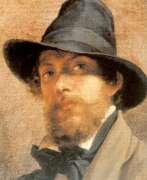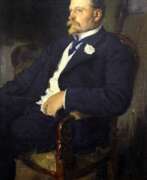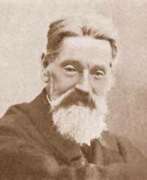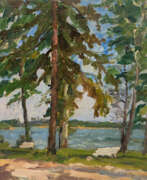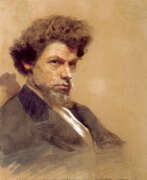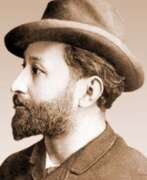Painters Itinerants
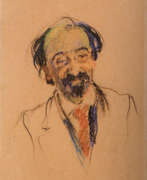

Manuel Khristoforovich Alajalov (Russian: Мануил Христофорович Аладжалов) was a prominent Russian and Soviet landscape painter and educator, born in 1862 in Nakhichevan-on-Don. Alajalov's work is distinguished by his exquisite landscapes that capture the essence of the Russian countryside. His paintings are noted for their masterful use of light and shadow, bringing a serene and lifelike quality to his depictions of nature.
Alajalov's career was marked by a deep commitment to portraying the natural world with authenticity and emotion. His art reflects a profound appreciation for the tranquility and beauty of rural Russia, making him a significant figure in the history of Russian art. Alajalov's legacy as a teacher also influenced many aspiring artists of his time, further cementing his place in the artistic community.
Alajalov's works are showcased in several major Russian museums, including the State Tretyakov Gallery, where art enthusiasts can experience his contribution to landscape painting. His paintings continue to be celebrated for their technical excellence and emotional depth, attracting collectors and admirers from around the world.
For updates on new product sales and auction events related to Manuel Khristoforovich Alajalov, sign up for our newsletter. Stay informed about exclusive opportunities to own a piece of this celebrated artist's legacy.
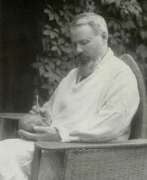

Nikolay Andreyevich Andreyev (Russian: Николай Андреевич Андреев) was a distinguished Russian sculptor, graphic artist, and stage designer, whose works have significantly contributed to the artistic landscape of early 20th-century Russia. Born into the rich cultural milieu of Moscow in 1873, Andreyev emerged as a pivotal figure associated with the Peredvizhniki group, a movement that sought realism and social critique through art. His early education under Sergey Volnukhin paved the way for a career that spanned various forms of artistic expression, including sculpture and graphic design.
Andreyev's works are known for their dynamic representation of figures and profound social commentary. Perhaps his most famous creation is the bronze statue of the celebrated writer Nikolai Gogol, unveiled in 1909. This statue, surrounded by bronze friezes depicting Gogol's characters, initially stood on Gogol Boulevard in Moscow. Its impressionistic style, however, attracted criticism, leading to its relocation in 1952. Another notable work, the "Woman reaper with a child," showcases Andreyev's adeptness at capturing the essence of Russian cultural symbols through sculpture. Cast in bronze, this work reflects Andreyev's ability to convey complex themes such as motherhood and labor with sensitivity and depth.
In his later years, Andreyev's artistic direction veered towards Socialist Realism, producing a prolific array of Leniniana - sculptures and graphic works of Vladimir Lenin. His commitment to this genre was profound, with around 100 sculptures and 200 graphic works dedicated to Lenin, marking a significant contribution to Soviet artistic propaganda. Additionally, his portrait of Lev Tolstoy stands as a testament to his versatility and depth as an artist, capturing the essence of the literary giant with striking realism.
Andreyev's legacy extends beyond his artistic achievements, with his works residing in prestigious collections such as the Tretyakov Gallery. His death in 1932 marked the end of a vibrant chapter in Russian art history, but his contributions continue to be celebrated for their artistic merit and historical significance.
For collectors and experts in art and antiques, the works of Nikolay Andreyevich Andreyev offer a unique glimpse into the cultural and political nuances of Russia during a transformative era. His sculptures not only stand as remarkable feats of artistic expression but also as enduring symbols of Russia's rich cultural heritage.
If you're intrigued by Andreyev's profound contributions to art and wish to explore his works further, consider signing up for updates. This subscription will keep you informed about new product sales and auction events related to Nikolay Andreyevich Andreyev, offering exclusive insights into the world of art and antiques.
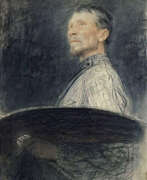

Abram Efimovich Arkhipov (Russian: Абра́м Ефи́мович Архи́пов) was a distinguished Russian realist artist, celebrated for his profound contributions to the world of art through his depictions of Russian peasantry and rural landscapes. Born in the village of Yegorovo, Ryazan Oblast, in 1862, Arkhipov's early life in a peasant family deeply influenced his thematic focus and artistic direction. His education at the Moscow School of Painting, Sculpture and Architecture, and later at the Imperial Academy of Arts, under the tutelage of prominent Russian artists such as Vasily Perov, Vasily Polenov, and Vladimir Makovsky, honed his skills and shaped his artistic vision.
Arkhipov's membership in the art collective The Wanderers and the Union of Russian Artists underscored his commitment to exploring the lives and struggles of Russian women and peasants, themes that recur throughout his work. His realist paintings often depicted the grim realities faced by these subjects, yet he also celebrated their resilience and spirit, as seen in his vibrant portrayals of peasant women in traditional dresses. Furthermore, Arkhipov's dedication to plein air painting allowed him to capture the essence of rural Russia and the northern landscapes with authenticity and emotional depth.
His notable works, such as "The Washer Women" and "Spring Holiday," are celebrated for their intricate depiction of Russian life and culture, providing viewers with a window into the soul of the Russian people. These masterpieces, along with others, have earned places in prestigious museums and galleries, including The Metropolitan Museum of Art, where his work "Ivan Rodin" from 1928 is part of their collection, symbolizing his enduring legacy in the world of art.
For collectors and experts in art and antiques, Arkhipov's works represent not only significant artistic achievements but also important cultural artifacts that offer insights into the historical and social contexts of his time. His paintings are a testament to his skill, sensitivity, and unique perspective on the Russian way of life, making him a pivotal figure in the Russian realist movement.
To stay updated on new product sales, auction events, and more insights into the world of Abram Yefimovich Arkhipov, consider signing up for updates. This subscription is a gateway to exploring the rich tapestry of Russian culture and art, as seen through the eyes of one of its most poignant chroniclers.
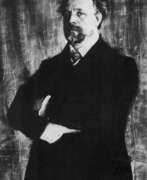

Vasily Nikolayevich Baksheyev (Russian: Василий Николаевич Бакшеев) was a distinguished Russian painter, celebrated for his contributions to landscape, interior, still life, and genre painting. His works are emblematic of the Union of Russian Artists' spirit, a movement he was closely aligned with throughout his career. Born in Moscow in 1862, Baksheyev was a prodigious talent who honed his craft at the esteemed Moscow School of Painting, Sculpture, and Architecture from 1877 to 1888, under the tutelage of luminaries such as Vladimir Makovsky, A. K. Savrasov, and V. D. Polenov. His artistic journey was marked by a significant award early on—a large silver medal for "The Return of Pilgrimage" in 1889—and travels to cultural hubs like Paris and Munich in 1895, which broadened his artistic horizons.
Baksheyev's artistry evolved over the years, from initial genre pictures to a profound exploration of landscape painting, for which he is most renowned. His works, especially from the Soviet era, continue the rich tradition of Russian lyrical landscape, imbued with a poetic quality that captures the essence of nature's transient beauty. His teaching career and efforts in organizing regional museums further underscore his commitment to art and community. Baksheyev's legacy is preserved in his poignant and luminous paintings, such as "Twilight," "Birches," and "Sunny Day," which offer a glimpse into the serene and vibrant landscapes of the Tarusa region. His work remains an invaluable part of Russia's cultural heritage, housed in numerous museums across the country and celebrated for its artistic integrity and emotional depth.
For art collectors and enthusiasts, Baksheyev's oeuvre represents a pivotal chapter in the evolution of Russian painting, characterized by its lyrical beauty and emotive power. His ability to blend impressionistic brushwork with symbolic imagery creates a unique visual language that speaks to the heart of the Russian landscape tradition.
To stay updated on new insights and opportunities related to Vasily Nikolayevich Baksheyev, including sales and auction events, signing up for updates is highly recommended. This subscription ensures that enthusiasts and collectors alike are always informed about the latest developments and available works related to this exceptional artist.
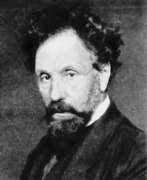

Nikolai Kornilievich Bodarevsky (Russian: Николай Корнилиевич Бодаревский) was a Russian and Ukrainian artist of the last third of the 19th and early 20th centuries of Moldavian origin. He is known as a painter and graphic artist.
Nikolai Bodarevsky created portraits, landscapes and genre paintings. During the early period of his creativity, he was close to the Itinerants, in later years he departed from the Itinerant traditions in the direction of the late "salon" academism. His works are in many museum collections, including the State Tretyakov Gallery in Moscow and the State Russian Museum in St. Petersburg.
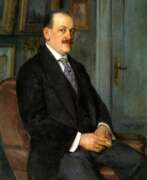

Nikolay Petrovich Bogdanov-Belsky (Russian: Николай Петрович Богданов-Бельский) was a renowned Russian artist, celebrated for his genre paintings depicting the education of peasant children, as well as portraits and impressionistic landscapes. Born in 1868 in Shitiki, Smolensk Governorate, Bogdanov-Belsky added "Belsky" to his surname from the district where he was born. His academic journey in art began at the Semyon Rachinsky fine art school, followed by studies at the Moscow School of Painting, Sculpture and Architecture, and later at the Imperial Academy of Arts in St. Petersburg.
Throughout his career, Bogdanov-Belsky was an active participant in Russian artistic circles, becoming a member of the Peredvizhniki from 1895 and the Arkhip Kuindzhi Society from 1909. His works often centered around the themes of rural education and childhood, capturing the subtle interplay of light and shadow and the innocence of his subjects. Notable works include "Mental Arithmetic, in the Rachinsky School" (1895) and "Sunday reading in a village school" (1895), which reflect his deep engagement with the theme of education.
After the Soviet Union came into power, the political climate and the disfavor towards realism compelled him to move to Riga, Latvia in 1921, where he continued his artistic endeavors until his death in Berlin in 1945 due to an Allied bombing during World War II.
For collectors and enthusiasts of Russian art, Bogdanov-Belsky's works offer a poignant glimpse into pre-Soviet Russian culture and education. His paintings are not only aesthetically pleasing but also historically significant, capturing the essence of a bygone era. To stay updated on sales and auction events featuring works by Nikolay Petrovich Bogdanov-Belsky, consider signing up for updates. This subscription will ensure you are informed about new opportunities to acquire pieces by this illustrious artist.
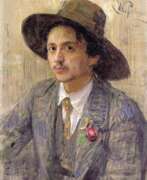

Isaak Israelievich Brodsky (Russian: Исаак Израилевич Бродский), a distinguished Russian artist, was renowned for his contributions to painting and teaching. Born in Sofievka, Russian Empire, Brodsky's artistic journey led him to become a pivotal figure in the Soviet art scene, primarily recognized for his realistic portraits and social realist works. His dedication to capturing the essence of his subjects, combined with a unique sensitivity to color and form, allowed his art to transcend mere representation, offering insights into the culture and political climate of his time.
Throughout his career, Brodsky was closely associated with significant cultural and political developments in Soviet Russia, becoming an official artist of the Soviet regime. His works, such as the iconic portraits of Lenin and other political figures, not only exemplify his skill but also serve as historical documents, offering a glimpse into the era's social fabric. His commitment to realism and the portrayal of Soviet ideals earned him a prominent place in the art world, influencing generations of artists through his role as a teacher and mentor at the Repin Institute of Arts.
Brodsky's legacy is preserved in numerous museums and galleries, with his masterpieces forming an integral part of Russia's cultural heritage. His ability to intertwine art with historical narrative has made his work a subject of study for art collectors and experts alike. For those intrigued by the depth and historical significance of Soviet art, Brodsky's oeuvre offers a fascinating exploration into the power of visual storytelling.
For collectors and experts keen on delving deeper into the rich tapestry of Russian art, staying informed about Isaac Israelievich Brodsky's work is essential. Signing up for updates ensures exclusive access to news on product sales and auction events dedicated to Brodsky's art, providing a unique opportunity to engage with the history and culture he so vividly depicted. Join us in celebrating the legacy of a true maestro of painting, whose works continue to inspire and captivate audiences worldwide.
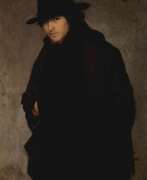

Philipp Antonovich Chirko (Russian: Филипп Антонович Чирко) was a Russian and Ukrainian painter, born on July 3, 1859, in Kyiv. Chirko was known for his realistic style and was associated with the Peredvizhniki movement, a group of artists committed to social realism and traveling exhibitions. He studied at the Kyiv Drawing School and later at the Imperial Academy of Arts in Saint Petersburg, graduating in 1892.
Chirko’s works often depicted battle scenes, genre paintings, and landscapes of Ukraine. Notable paintings include "The Pursuit of French Mounted Chasseurs by the Horse Guards under Polotsk on August 6, 1812," which is part of the Borodino Panorama Museum's collection in Moscow. Unfortunately, many of his works were lost during World War II.
Chirko’s remaining works are highly valued by collectors and can be found in various Russian museums, including the Chernihiv Art Museum. His contribution to art is significant for its historical and artistic value, capturing the essence of his era.
Sign up for updates related to Philipp Antonovich Chirko to receive notifications about new product sales and auction events.


Mikhail Konstantinovich Clodt (Russian: Михаил Константинович Клодт) was a Russian landscape painter of German origin in the second half of the 19th century. He was one of the first to introduce genre motifs into the landscape genre.
Mikhail Clodt is known for his unique painting style. His works are characterized by serenity, rigorous composition, detailed drawing of the smallest objects. The presence of human figures on canvas animates and elevates the nature.
Clodt actively worked in the Board of the Association of Traveling Exhibitions, whose goal was to acquaint residents of the province with academic painting. The works of Mikhail Clodt are among the masterpieces of world art and were repeatedly presented to the public at international exhibitions organized in European capitals.
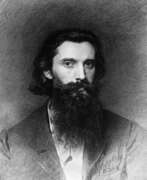

Nikolai Dmitrievich Dmitriev-Orenburgsky (Russian: Николай Дмитриевич Дмитриев-Оренбургский) was a Russian painter born in 1837 in Nizhny Novgorod. He is renowned for his battle scenes and depictions of Russian village life. Dmitriev-Orenburgsky studied at the Imperial Academy of Arts in St. Petersburg, where he was part of the ‘revolt of fourteen’—a group of students who challenged the conservative academic traditions of their time.
Dmitriev-Orenburgsky's work often reflected the harsh realities of rural Russian life, with a notable melancholic undertone even in his more cheerful scenes. His involvement in the Russo-Turkish War (1877-78) profoundly influenced his art, leading to several acclaimed battle paintings. Some of his significant works include "General M. D. Skobelev on his Horse" and "Siege of Plevna," which are housed in prestigious collections such as the Hermitage Museum and the Russian Museum.
His genre paintings, like "Sunday in a Village" and "Fire in a Village," capture the essence of Russian peasant life with striking realism and emotional depth. Dmitriev-Orenburgsky's legacy is celebrated for its historical significance and artistic excellence, making his works highly sought after by collectors and exhibited in major galleries worldwide.
Stay informed about upcoming sales and auctions featuring works by Nikolai Dmitrievich Dmitriev-Orenburgsky by signing up for our updates. Subscribe now to receive alerts on new product sales and auction events related to this distinguished artist.
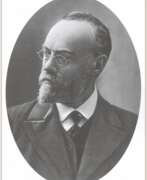

Nikolay Nikanorovich Dubovskoy (Russian: Николай Никанорович Дубовской) was a distinguished Russian landscape painter, renowned for his significant contributions to the "Landscape of Mood" movement alongside Isaac Levitan. Born into a Don Cossack family in Novocherkassk in 1859, Dubovskoy demonstrated artistic talent from an early age, initially encouraged by his uncle A.V. Pyshkin. Despite his father's initial insistence on a military career, Dubovskoy pursued his passion for art, studying under Mikhail Clodt at the Imperial Academy of Arts and later refusing a conventional academic path to instead exhibit with the Imperial Society for the Encouragement of the Arts. His work, "Winter," gained him early recognition when acquired by the Tretyakov Gallery in 1884.
Dubovskoy's legacy includes several masterpieces, such as "After the Rain," a beautiful example of his mature period that demonstrates the influence of French Impressionism, with its open composition and luminous treatment of light. This piece and others underline his mastery in capturing the nuanced interplay of light and atmosphere, resonating with both the Impressionist and Itinerant movements. Unfortunately, the distribution of his works across various museums after his death and the Soviet Union's collapse has made accessing his complete oeuvre challenging, requiring a journey across multiple countries.
Dubovskoy's contributions to Russian landscape painting and his unique ability to evoke mood and atmosphere in his works have cemented his place among the greats of the art world. His paintings, such as "The Calm Evening," praised as a "poem in gold" by critics, demonstrate his exceptional skill in rendering the delicate interplay of light and color. For those interested in exploring the depths of Russian landscape painting, Nikolay Nikanorovich Dubovskoy's works offer a rich and emotive experience, embodying the spirit of an era and the beauty of the Russian landscape.
To stay updated on sales and auction events featuring works by Nikolay Nikanorovich Dubovskoy, sign up for our updates. This subscription will ensure you're informed about new opportunities to appreciate and acquire pieces by this illustrious artist, focusing solely on relevant product sales and auction events.
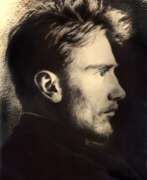

Grigory Kononovich Dyadchenko (Russian: Григорий Кононович Дядченко) was a Ukrainian artist and educator, born on October 8, 1869, in Kirilovka. Known for his landscape and portrait paintings, Dyadchenko's work embodies the realism movement. He studied at the Kyiv Drawing School and later graduated from the Imperial Academy of Arts in St. Petersburg, where he earned multiple awards.
Dyadchenko's artistry is evident in his poetic landscapes such as "Evening on the Dnieper" and "Kiev. View of Podil," which are characterized by their atmospheric depth and emotional resonance. His portraits, including "Head of a Girl" and the depiction of sculptor F. Balavensky, are celebrated for their psychological insight.
Dyadchenko also contributed to art education by teaching at the Kyiv Drawing School, influencing future artists like Mykhailo Kozyk and Vasyl Sylvestrov. His works are preserved in the National Art Museum of Ukraine and other prominent collections.
For those interested in Dyadchenko's art, sign up for updates on new product sales and auction events related to his masterpieces.


Gavriil Nikitich Gorelov (Russian: Гавриил Никитич Горелов) was a Russian and Soviet artist of the first half of the twentieth century. He is known as a painter, graphic artist and teacher.
Gavriil Gorelov studied at the St. Petersburg Academy of Arts under Ilya Repin and Franz Roubaud. He created historical canvases, genre paintings and portraits. During a study trip to Italy, he painted "Orgy in the apartments of Alexander VI Borgia". Returning to Russia, the artist became a member of the Association of Traveling Art Exhibitions. Among his famous works are "Pugachev's Trial of a Landowner", "Pugachev's Execution", "Bolotnikov's Revolt", "Minin's First Appeal to the People", "Dogs-Knights". He also participated in the creation of the panorama "The Storming of Perekop".
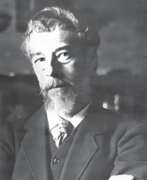

Pyotr Petrovich Gosławski (Russian: Пётр Петрович Гославский) was a Russian painter and graphic artist, known for his landscape paintings and illustrations. Born on January 29, 1871, in Saint Petersburg, he belonged to a noble family. Gosławski's works are celebrated for their realistic and impressionistic styles, reflecting the beauty of the Russian countryside and everyday life.
Gosławski's contributions to the art world include participation in numerous exhibitions and his works being held in prestigious collections like the Tretyakov Gallery. His ability to capture light and texture made his landscapes particularly admired. Additionally, he illustrated several works of Russian literature, adding to his legacy as a versatile artist.
Gosławski's works continue to be appreciated in various regional museums and private collections. He passed away in 1919 from typhus, leaving behind a rich artistic heritage. Sign up for updates on Pyotr Petrovich Gosławski to stay informed about new product sales and auction events related to his works.


Sergey Vasilyevich Ivanov (Russian: Сергей Васильевич Иванов), born on June 16, 1864, in Ruza, Moscow Governorate, was a distinguished Russian artist renowned for his genre and history paintings. Ivanov's work is celebrated for its embodiment of social realism, a style that vividly portrays social and political conditions. He is most noted for his profound engagement with historical themes and the social issues of his time, particularly through his exploration of the resettlement of peasants to Siberia following the Emancipation reform of 1861. This period marked a significant focus in his career, where he dedicated his art to depicting the challenging journeys and lives of these migrants, often highlighting the hardships they endured.
Ivanov's early life was shaped by his family's initial resistance to his artistic pursuits, leading him to study at the Konstantinov Land Surveying Institute before finally being able to follow his passion for art at the Moscow School of Painting, Sculpture and Architecture. This education laid the groundwork for his illustrious career, during which he developed a series of poignant works that delve into the peasant resettlement process and the lives of convicts, capturing the essence of their struggles with a compassionate lens. Notable works such as "The Fugitive" and "The Dispatch of the Prisoners" are celebrated for their emotional depth and are housed in prestigious collections, including the Tretyakov Gallery in Moscow.
In the latter part of his career, Ivanov turned his attention to historical paintings, where his talent continued to flourish. His historical works are lauded for their vivid portrayal of Russian national character and critical moments in the nation's history. Ivanov's contributions to Russian art were recognized by his membership in the Peredvizhniki and the Union of Russian Artists, through which he played a significant role in the artistic movements of his time.
Sergey Vasilyevich Ivanov's legacy is that of a master storyteller who utilized his brush to reflect on the social realities of Russia, earning him a place among the most influential Russian artists of his era. His works remain a valuable resource for understanding the cultural and historical landscape of 19th-century Russia, offering insights into the struggles and resilience of its people.
For collectors and experts in art and antiques, Ivanov's oeuvre presents a compelling exploration of Russian culture and history, imbued with a deep sense of humanity and realism. His paintings not only serve as artistic achievements but also as historical documents that convey the profound changes and challenges of his time.
To stay informed about new product sales and auction events related to Sergey Vasilyevich Ivanov, signing up for updates is highly recommended. This subscription ensures access to the latest information and opportunities to acquire works by this eminent artist, enriching collections with pieces of significant cultural and historical value.
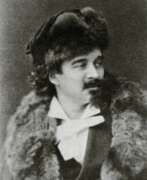

Valery Ivanovich Jacobi (Russian: Валерий Иванович Якоби), a distinguished Russian painter, is celebrated for his significant contributions to the art world, particularly in the realms of culture, painting, and sculpture. Born in the mid-19th century, Jacobi's artworks encapsulate the essence of Russian life, history, and landscapes, showcasing his profound understanding and appreciation of his homeland's spirit.
Jacobi's talent was not confined to a single genre; instead, he excelled in portraying historical scenes, everyday life, and landscapes with equal finesse. His paintings are renowned for their vivid storytelling, attention to detail, and the ability to evoke emotion. Jacobi's work offers a window into the Russian soul, reflecting the nation's culture and traditions through the lens of art. His mastery over color and form allowed him to create pieces that are not only visually stunning but also rich in narrative and depth.
Several of Jacobi's masterpieces have found homes in prestigious museums and galleries, marking him as a pivotal figure in Russian art history. His contributions have left an indelible mark on the art world, influencing generations of artists and art aficionados alike. For collectors and experts in art and antiques, Jacobi's works represent a valuable intersection of historical significance and aesthetic beauty, making them highly sought after in the art market.
For those intrigued by the legacy of Valery Ivanovich Jacobi and wish to delve deeper into the world of Russian art and culture, signing up for updates can be a rewarding endeavor. Subscribing will not only keep you informed about new product sales and auction events related to Jacobi's work but also offer insights into the broader realm of art and antiques. This opportunity allows enthusiasts to stay connected with the vibrant history and ongoing appreciation of Jacobi's contributions to the art world.
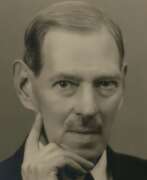

Anatoly Dmitrievich Kaigorodov (Russian: Анатолий Дмитриевич Кайгородов) was a Russian painter, renowned for his contributions to modernism, particularly in the realms of landscapes, genre scenes, and portraits. Born on November 2, 1878, in St. Petersburg, Kaigorodov trained at the Stieglitz School of Fine Arts and later studied under prominent artists such as Archip Kuindzhi in St. Petersburg and Simon Hollosy in Munich. His education continued in Paris at the Julian Academy and Colarossi's studio, where he honed his artistic skills.
Kaigorodov's work is distinguished by its atmospheric depictions of nature, especially seascapes, and he was a master of tempera, which he used to create nuanced effects of light and color. His first exhibition was at the St. Petersburg Academy of Arts in 1900, marking the beginning of a prolific career. He became a member of the Peredvizhniki, a group of Russian realist artists, and won several prestigious awards, including the Kuindzhi Prize.
Throughout his career, Kaigorodov exhibited internationally, with works displayed in Germany, the Netherlands, and the United States. Notable pieces such as "Seashore" earned him accolades like the Carnegie Medal. His paintings are held in major collections, including the Tretyakov Gallery in Moscow and the Art Museum of Estonia in Tallinn.
For collectors and art enthusiasts, following Kaigorodov's legacy offers a glimpse into the rich tapestry of Russian modernism. Sign up for updates on new sales and auction events featuring Anatoly Dmitrievich Kaigorodov's works to add a piece of this esteemed artist to your collection.
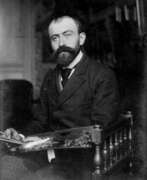

Aleksei Alekseevich Kharlamov (russian: Алексей Алексеевич Харламов) was a Russian artist renowned for his portrait paintings. Born in 1840 in Saratov, Russia, Kharlamov displayed artistic talent from an early age, eventually studying under the guidance of Professor A. T. Markov at the Imperial Academy of Arts. His dedication to art was rewarded with several medals during his academic years, and his piece titled "Baptism of Kiev" earned him a prestigious gold medal in 1866.
Kharlamov spent much of his career in Paris, where he was deeply influenced by Western European artistic movements. His works often featured delicate and finely detailed representations of women and children, capturing the subtleties of expression and mood which became his signature style. Notably, his painting "Young Woman and Child" from 1894 showcases his adept use of light and texture to portray serene domestic scenes, a piece that is currently held in the Bowdoin College Museum of Art.
Throughout his career, Kharlamov was associated with prominent cultural figures such as the novelist Ivan Turgenev, and he participated actively in the Parisian art scene. His portraits were highly sought after, with clients paying substantial sums for his works, reflecting his status as a distinguished portraitist of his time.
For those interested in exploring the works of Aleksei Alekseevich Kharlamov and the rich cultural tapestry of his era, signing up for updates on auctions and events featuring his art can provide valuable insights and opportunities to acquire pieces by this notable artist. Stay informed about the latest sales and exhibitions by subscribing to our newsletter dedicated to Kharlamov’s legacy.
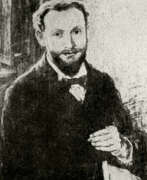

Solomon Yakovlevich Kishinevsky (Russian: Соломон Яковлевич Кишинёвский) was a Russian and Soviet artist of the late 19th and the first half of the 20th centuries of Jewish origin. He is known as a painter, graphic artist and teacher, a prominent representative of the Southern Russian school of painting.
Solomon Kishinevsky worked in domestic, portrait and landscape genres. At the beginning of his career, he was fond of German and Italian classicism, then French impressionism, but the first serious works he created under the strong influence of the Itinerants. His life sketches, scenes from the life of the urban poor were acutely social, the artist has a special attention to the everyday existence of the "little man.
Kishinevsky died presumably in 1941 during the Nazi occupation of Odessa.


Stepan Fedorovitch Kolesnikoff (Russian: Степан Федорович Колесников) was a Ukrainian realist painter renowned for his exceptional ability to capture the essence of Ukrainian nature and rural life. Born in 1879 in the Russian Empire and passing in 1955 in Belgrade, Yugoslavia, Kolesnikoff's journey began in a humble peasant family. His artistic talent was evident early on, leading him to the Odessa Art School and subsequently, without exams, to the prestigious Imperial Academy of Arts. Here, he was not only a student but also thrived, winning numerous awards for his work.
Kolesnikoff's art is characterized by its focus on the natural awakening of landscapes, melting snows, floods, and the vibrant days of spring. He also had a keen interest in painting domestic scenes filled with people and animals, often using a palette of blues and bright oranges. Despite the rich detail in his paintings, Kolesnikoff rarely highlighted the faces of his subjects, preferring instead to capture the essence of the moment. His work received high praise from Ilya Repin, a leading Russian artist of the time, underscoring Kolesnikoff's significant impact on realism.
After emigrating to the Balkans in 1919 due to the political upheaval in Russia, Kolesnikoff settled in Belgrade where he continued his artistic career. He was warmly welcomed and even participated in state assignments, such as leading restoration works on paintings and frescoes. Kolesnikoff's legacy extends beyond his paintings; he was a respected member of the artistic community, contributing to societies like the "Community of Artists" and "Leonardo da Vinci".
For collectors and experts in art and antiques, Kolesnikoff's work represents a fascinating blend of cultural and historical narratives, imbued with the beauty of Eastern European landscapes and life. His contributions to realism and his unique approach to depicting rural life make his works highly sought after.
To stay updated on exhibitions and auction events featuring Stepan Fedorovitch Kolesnikoff's works, signing up for updates can provide exclusive insights and opportunities to acquire pieces by this remarkable artist.


Sergei Alekseyevich Korovin (Russian: Серге́й Алексе́евич Коро́вин) was a Russian Realist painter, celebrated for his authentic portrayal of Russian life and landscapes. Born on August 19, 1858, in Moscow into a wealthy merchant family of Old Believers, Korovin's background was as rich and complex as his art. His education at the Moscow School of Painting, Sculpture, and Architecture under the tutelage of Vasily Perov, Alexei Savrasov, and Illarion Pryanishnikov, a distant relative, laid the foundation for his artistic journey. His teaching stint at the same school and membership in the "Union of Russian Artists" highlighted his commitment to the Russian art scene.
Korovin's masterpiece "На миру" (1893), depicting an obshchina meeting aimed at resolving a dispute, stands as a testament to his ability to capture the essence of Russian societal dynamics post-emancipation of the serfs. His later works showcased a transition towards Impressionism, marking his versatility and depth as an artist. Notably, his contributions to the artistic world were not limited to paintings alone; he also ventured into illustrations, such as those for Gogol's "The Overcoat", and decorative paintings, including a depiction of the Battle of Kulikovo at the State Historical Museum.
Despite a career overshadowed by his more famous brother, Konstantin Korovin, Sergei's dedication to Russian art and culture remains undeniable. His sudden death in 1908 due to heart failure cut short a life of artistic exploration and expression.
For enthusiasts and collectors of Russian art, Sergei Alekseyevich Korovin's works offer a unique window into the soul of Russia during a pivotal time in its history. To stay updated on new discoveries and auction events related to Korovin's art, sign up for updates. This subscription is your gateway to the rich world of Korovin's contributions to Russian Realism and Impressionism.
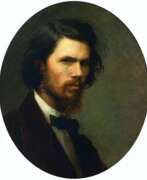

Ivan Nikolayevich Kramskoi (Russian: Иван Николаевич Крамской), a distinguished Russian painter and art critic, emerged as a pivotal figure in the Russian art scene during the latter half of the 19th century. Born into modest circumstances in 1837, Kramskoi's journey from a retoucher and watercolorist to a leading intellectual force in the art movement known as the Wanderers, or Peredvizhniki, underscores his dedication to art and its societal impact. His education at the St. Petersburg Academy of Arts was a turning point, leading to his active rebellion against academic art through the "Revolt of the Fourteen," which culminated in the formation of the Artel of Artists, a group advocating for realism and the moral duty of the artist.
Kramskoi's oeuvre is celebrated for its masterful portraits, which he paradoxically considered a burden yet excelled in, creating around 3,000 pieces that captured the essence of his subjects with unparalleled depth. His portraits of Russian writers, scientists, artists, and public figures are notable for their expressive simplicity and profound psychological insight, reflecting his democratic ideals and the belief in the artist's societal role. Among his well-known works are "Christ in the Desert" (1872), "Portrait of an Unknown Woman" (1883), and "Inconsolable Grief" (1884), all housed in the Tretyakov Gallery, showcasing his ability to blend portraiture with genre painting to explore complex emotions and moral-philosophical themes.
Despite his critical stance on portrait painting as mere means to support his family, Kramskoi's legacy is largely defined by these works, revealing the tensions between his artistic aspirations and the demands of livelihood. His leadership in the Association of Traveling Art Exhibitions (Peredvizhniki) significantly influenced Russian art, championing realism and accessibility of art to the public.
Kramskoi's personal life, marked by a marriage born out of a romantic and ideological alignment with the values of his time, and his untimely death at the age of 49 from an aortic aneurysm, add a poignant note to his story. His contributions to art and his critical perspectives on its role in society continue to be revered, making him an essential figure in the study of Russian realism and the broader art historical canon.
For collectors and experts in art and antiques, Kramskoi's works represent not only exceptional artistic achievements but also a window into the cultural and social dynamics of 19th-century Russia. His dedication to capturing the human spirit, whether in the guise of famous personalities or common folk, ensures his enduring relevance and appeal.
To stay updated on sales and auction events related to Ivan Nikolayevich Kramskoi's works, signing up for updates is a pragmatic step for enthusiasts keen on exploring the depths of Russian art and culture. This subscription is a gateway to engaging with the legacy of a painter who skillfully balanced personal conviction with public duty, leaving behind a rich trove of art that continues to inspire and captivate.


Arkhip Ivanovich Kuindzhi (Russian: Архип Иванович Куинджи) was a Russian landscape painter of Greek descent, celebrated for his pioneering use of light and color to evoke dramatic atmospheres. Born into a shoemaker's family in Mariupol, Ukraine, Kuindzhi faced early hardships, including the loss of his parents at a young age. Despite these challenges, his passion for art led him to Saint Petersburg, where he largely taught himself to paint, although he briefly studied at the St. Petersburg Academy of Arts and was influenced by the renowned marine artist Ivan Aivazovsky.
Kuindzhi's work stands out for its innovative approach to capturing the natural world, particularly his use of light to create mood and atmosphere. His paintings, such as "Moonlit Night on the Dnieper" (1880), "The Birch Grove" (1879), and "Red Sunset on the Dnieper" (1905–1908), demonstrate his skill in portraying the luminous qualities of the landscape, often with a dramatic and almost mystical quality. His landscapes are not just representations of nature but are imbued with a sense of the sublime, reflecting his lifelong interest in the scientific and philosophical studies of light and perception, a curiosity partly nurtured through his friendship with the chemist Dmitri Mendeleev.
Despite achieving significant acclaim, including the patronage of notable figures like Pavel Tretyakov, Kuindzhi withdrew from public life at the peak of his career. This withdrawal, however, did not diminish his impact on the art world; he continued to influence future generations as a professor at the St. Petersburg Academy of Arts, where he taught artists such as Nicholas Roerich and Arkady Rylov. His commitment to art and education culminated in the formation of the Society of Artists, which was later named in his honor.
Kuindzhi's legacy is preserved in major institutions like the State Russian Museum and the Tretyakov Gallery, where his masterpieces continue to inspire awe and admiration. His works offer a window into the soul of the Russian landscape, reflecting a blend of his Greek, Tatar, Ukrainian, and Russian heritage.
For art collectors and experts, Kuindzhi's paintings represent not only aesthetic beauty but also the rich cultural and historical contexts from which they emerged. His innovative techniques and the emotional depth of his work continue to captivate audiences, making him a pivotal figure in the world of landscape painting.
To stay informed about new product sales and auction events related to Arkhip Ivanovich Kuindzhi, consider signing up for updates. This subscription is an excellent opportunity for collectors and art enthusiasts to engage with the ongoing legacy of this remarkable artist.
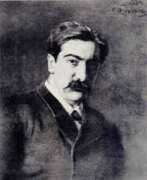

Nikolai Dmitriyevich Kuznetsov (Russian: Николай Дмитриевич Кузнецов) was a Ukrainian artist, celebrated for his profound skill in portraiture and genre scenes. Born on December 2, 1850, in the Kherson Governorate of the Russian Empire, he rose to prominence as an art professor at the St. Petersburg Imperial Academy of Arts. His works, notably his portraits, are known for their depth and psychological insight, capturing the essence of his subjects with remarkable clarity.
Kuznetsov's portfolio includes influential Russian figures such as the composer Pyotr Ilyich Tchaikovsky, whose portrait by Kuznetsov is praised for capturing the composer's introspective tragedy. This piece remains a highlight at the Tretyakov Gallery, illustrating Kuznetsov’s ability to translate the inner life of his subjects onto canvas.
Throughout his career, Kuznetsov was involved with the Peredvizhniki, a group of artists who eschewed the formal constraints of academic art to focus on realistic portrayals of everyday life. He became an academician in 1900 and continued to influence the Russian art scene until his emigration to Yugoslavia following the upheaval of the Russian Civil War. He passed away on March 2, 1929, in Sarajevo.
For those interested in exploring Nikolai Dmitriyevich Kuznetsov’s life and works further, updates and details about upcoming sales and exhibitions can be found by subscribing here. Stay informed about the availability of his renowned artworks and ensure you don't miss out on acquiring a piece of art history.


Carl Johann Lemoch (Russian: Кирилл Викентьевич Лемох) was a Russian painter of the last third of the 19th and early 20th centuries of German origin. He is known as a painter, graphic artist and miniaturist.
Lemoch is considered one of the most notable genre painters in Russia of his time. The leading place in his work was occupied by the peasant theme, which was characterized by a sympathetic image of the hardships of everyday life of peasants. He was the first Russian artist to create miniature portraits with life-size figures.
Lemoch was one of the founders of the St. Petersburg Art Society of Artists and the Association of Traveling Art Exhibitions.


Isaac Ilyich Levitan (Russian: Исаак Ильич Левитан) was a distinguished Russian artist, celebrated for his profound contributions to the world of landscape painting. Born in 1860, Levitan's work is emblematic of the Russian landscape genre, capturing the emotive and atmospheric essence of the country's natural scenery. His artistry is not merely a depiction of the physical landscape but an exploration of the human emotion intertwined with the natural world, making his work resonate deeply with art collectors and experts alike.
Levitan's ability to infuse his landscapes with mood and emotion set him apart from his contemporaries. His paintings such as "The Vladimirka Road," "Above Eternal Peace," and "Golden Autumn" are lauded for their technical brilliance and emotive power. These works are showcased in prestigious museums, including the Tretyakov Gallery in Moscow, highlighting his importance in Russian culture and art history. Levitan's mastery in capturing the subtle transitions of light and his delicate portrayal of the seasons convey a profound sense of place and time, offering viewers a transcendent experience.
As an artist, Levitan's influence extends beyond his canvases, contributing significantly to the development of Russian landscape painting. His work embodies a unique blend of realism and impressionism, reflecting a deep connection to the Russian countryside. For collectors and experts in art and antiques, Levitan's paintings represent not only aesthetic beauty but also a rich cultural heritage. His legacy continues to inspire and captivate audiences, underscoring his status as a pivotal figure in the art world.
For those passionate about the intricacies of culture, art, and the storied canvas of history, Isaac Ilyich Levitan's oeuvre offers an unparalleled exploration of the Russian soul through landscape. We invite collectors and art enthusiasts to sign up for updates on new product sales and auction events related to Levitan's work. This subscription is your gateway to owning a piece of Russian artistic heritage, where the beauty of Levitan's landscapes can become a cherished part of your collection.
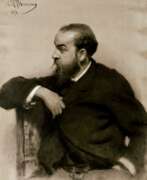

Rafail Sergeevich Levitsky (Russian: Рафаи́л Сергее́вич Леви́цкий) was a Russian artist of the last third of the 19th century to the first third of the 20th century. He is known as a painter-painter, photographer and teacher, professor of porcelain painting.
Rafail Levitsky painted genre paintings, portraits, landscapes, interiors, battle scenes from life. He is also considered the first artist in history to become a photographer. His many famous photographic portraits replaced models for painters, lithographers, illustrators, and engravers, as in the case of the portrait of Emperor Alexander III, which was reproduced on Russian banknotes.
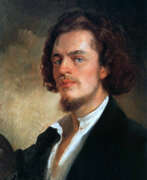

Konstantin Yegorovich Makovsky (Russian: Константин Егорович Маковский) was a renowned Russian painter, celebrated for his romantic and historical paintings that often portrayed an idealized view of Russian life in previous centuries. Born in Moscow in 1839, Makovsky became a pivotal figure in Russian art, distinguishing himself early on at the Moscow School of Painting, Sculpture and Architecture and later at the Imperial Academy of Arts in Saint Petersburg.
Makovsky was a core member of the "Peredvizhniki" or Wanderers, a group advocating for realism and social critique through art. His commitment to depicting the everyday life of old Russia won him accolades, including the Large Gold Medal at the World's Fair in Paris in 1889. Some of his notable works include "The Russian Bride's Attire" and "The Boyar Wedding Feast," which reflect his mastery in capturing the lavish and picturesque aspects of Russian history and culture.
Tragically, Makovsky's life ended in a road accident in Saint Petersburg in 1915, but his legacy lives on through his profound impact on Russian art and culture. His works continue to be highly regarded and are featured in major museums and collections worldwide.
For those interested in exploring Konstantin Makovsky's work further or acquiring pieces related to his artistic legacy, stay updated with our newsletters for announcements on sales and auction events. Sign up to not miss out on the opportunity to own a piece of Russian art history.


Nikolay Yegorovich Makovsky (Russian: Николай Егорович Маковский) was a Russian painter. Emerging from a family rich in artistic talent, including his siblings Konstantin, Vladimir, and Alexandra, Makovsky's early exposure to art was profound, influenced heavily by his father, Yegor Ivanovich Makovsky, who was not only an accountant but also an amateur artist and a founder of the Moscow School of Painting, Sculpture and Architecture.
Educated at the Imperial Academy of Arts from 1859 to 1866, Nikolay was awarded a silver medal in 1865 and later the title of "Free Artist." His career took a significant turn in 1870 when he joined the "Association of Travelling Art Exhibitions" (Peredvizhniki), a group pivotal in Russian art history for their traveling exhibitions, which aimed to make art accessible to the general public. Makovsky's contributions to this group began in earnest in 1875.
Nikolay Makovsky's works are characterized by their vivid portrayal of Russian life and landscapes. He traveled extensively, which enriched his art with varied themes and styles, reflecting his experiences in Russia, Ukraine, Egypt, and Paris. His time in Paris was particularly influential, allowing him to engage with the burgeoning art scene and further develop his own style.
For art collectors and experts, Nikolay Makovsky's paintings offer a glimpse into the cultural and historical milieu of 19th-century Russia, showcasing a blend of realism and romanticism. His works continue to be celebrated in galleries and museums, reflecting his significant contribution to Russian art and culture.
To stay updated on artworks and events related to Nikolay Yegorovich Makovsky, sign up for updates and notifications about new product sales and auction events connected to his works.
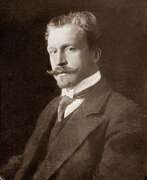

Aleksander Vladimirovich Makovsky, born on April 5, 1869, in Moscow, emerged as a distinguished figure in the realm of Russian Realist painting and graphic arts. His journey in art began within the noble confines of his family home in the Moscow province, where he honed his early skills. As a member of the esteemed Peredvizhniki, a group of itinerant painters, he imprinted his creative mark during a transformative period in Russian art.
Makovsky's oeuvre, comprising over 32 works, is a testament to his versatility and adeptness as both a painter and an illustrator. His Realist approach captured the zeitgeist of his era, infusing his canvases with a sense of immediacy and a connection to the Russian people and their experiences. His lineage—a noble dynasty known for its artistic contributions—further underscores the pedigree and cultural significance of his work.
The provenance of Makovsky's works includes an illustrious connection to Emperor Nicholas II, reflecting the high esteem in which his art was held among contemporaries. Such historical associations enhance the value and fascination of his pieces among collectors and art connoisseurs today.
For those intrigued by the legacy of Aleksander Makovsky and his contributions to Russian realism, further exploration of his works is a venture that promises rich rewards. As collectors and experts, delving into the world of Makovsky's artistry is not just an investment in art; it's an intimate encounter with history.
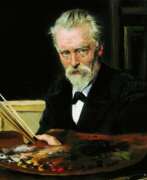

Vladimir Yegorovich Makovsky (Russian: Владимир Егорович Маковский), a distinguished Russian artist born in 1846 in Moscow, was celebrated for his genre paintings that vividly depicted everyday life with a blend of humor and social critique. His father, Yegor Ivanovich Makovsky, co-founded the Moscow School of Painting, Sculpture, and Architecture, where Vladimir later studied and taught, shaping the future of Russian art alongside his artistic family.
Makovsky's work often showcased small-town scenes and common folk, creating narratives that were both endearing and pointedly critical of societal injustices. Noteworthy pieces like "The Grape-juice Seller," "Fruit-Preserving," and "The Congratulator" highlight his skill in capturing the nuances of human expressions and interactions.
Throughout his career, Makovsky remained a pivotal member of the Peredvizhniki (Wanderers), a group dedicated to portraying real-life issues through art. His later works, such as "The Peddler" and "January 9, 1905, on Vasilyev Island," reflect his continued commitment to social themes, depicting historical events with deep empathy for the oppressed.
For art enthusiasts and collectors, Makovsky's works are pivotal in understanding the evolution of Russian realism. His paintings are held in high esteem and are featured in major museums around the world. To stay updated on exhibitions and sales related to Vladimir Yegorovich Makovsky, sign up for our newsletter, focusing exclusively on significant updates from the art world.


Sergey Vasilyevich Malyutin (Russian: Сергей Васильевич Малютин) was a distinguished Russian painter, architect, and designer, celebrated for his multifaceted contributions to the world of art and design. Born in Moscow in 1859 to a merchant family, Malyutin's artistic journey began after an exhibition by the Peredvizhniki inspired him to pursue art. His formal education at the Moscow School of Painting, Sculpture and Architecture honed his talents, leading to a diverse career that spanned painting, set design for operas and ballets, and architectural endeavors.
Malyutin is perhaps best known internationally for designing the first matryoshka doll in 1890, a seminal work that has become an iconic symbol of Russian culture. His involvement in the Arts and Crafts Movement influenced his work, integrating traditional Russian folk motifs into his designs and paintings. Notably, his architectural designs, including the Church of the Holy Spirit in Talashkino and the Pertsov House in Moscow, showcase his dedication to the Russian Revival movement, blending fantastic folk motifs with architectural creativity.
Throughout his career, Malyutin also played a significant role in education, teaching at the Moscow School of Painting, Sculpture and Architecture and advocating for Socialist Realism. His contributions to Russian art were not limited to his creations; he was instrumental in founding the Association of Artists of Revolutionary Russia, emphasizing the importance of art in societal development.
For those interested in exploring the legacy of Sergey Malyutin, his works offer a window into the fusion of traditional Russian art with the innovative currents of his time. Collectors and experts in art and antiques will find his contributions to Russian arts and crafts, especially his role in the creation of the matryoshka doll, to be of particular interest.
To stay updated on exhibitions and auction events featuring Sergey Vasilyevich Malyutin's work, sign up for updates. This subscription is an invaluable resource for enthusiasts looking to deepen their understanding of Malyutin's impact on Russian art and design.
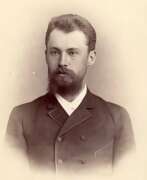

Nikolai Vasilievich Mescherin (Russian: Николай Васильевич Мещерин) was a Russian artist and entrepreneur born on February 28, 1864, in Moscow, and died on October 22, 1916, in Meshcherino, Russia. Known primarily for his landscape paintings, Mescherin initially embraced Impressionism, later experimenting with Pointillism, a technique developed by French Neo-Impressionists. His lyrical landscapes, often rendered in pastel, capture the serene beauty of Central Russia.
Mescherin was also a co-owner of the Moscow Danilovskaya Manufactory, balancing his industrial pursuits with his artistic endeavors. His works are significant for their emotional depth and technical precision, distinguishing him in the Russian art scene of the late 19th and early 20th centuries. Some of his notable works are housed in the Museum of Russian Impressionism in Moscow, where they continue to attract admiration from art enthusiasts and collectors.
For those interested in exploring more about Nikolai Vasilievich Mescherin's life and works, signing up for updates on new product sales and auction events related to his art is highly recommended. Stay informed about the latest opportunities to acquire pieces from this remarkable artist's collection.
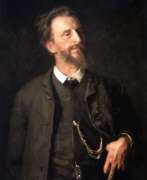

Grigori Grigorievich Myasoyedov (Russian: Григо́рий Григо́рьевич Мясое́дов) was a Russian artist of the second half of the nineteenth and early twentieth centuries. He is known as a bright representative of Russian realism and a founder of the Itinerant movement. In different years Myasoyedov turned to historical and everyday life genres, wrote portraits and landscapes. This versatile painter paid attention to religious subjects, his paintings depicted rituals, folk beliefs and customs.
Grigori Myasoyedov devoted the bulk of his career to depicting the life of the peasantry. Traveling and studying the works of Italian, German, Spanish and French artists, sculptors and architects, he was fascinated by critical realism, which flourished in Europe in the second half of the 19th century.
Determined to bring art closer to the average citizen, on his return to his homeland he founded the Association of Traveling Art Exhibitions and headed it. As one of the main participants of this movement, he himself traveled around the country with traveling exhibitions. Leaving the partnership after a conflict with the Impressionists, Myasoyedov concentrated on creativity. He created landscapes, tried his hand at graphics, and worked on theatrical sets.
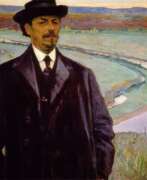

Mikhail Vasilyevich Nesterov (Russian: Михаи́л Васи́льевич Не́стеров), a distinguished Russian artist, was renowned for his unique contributions to the realms of painting and art, epitomizing the spiritual and cultural ethos of his era. Born into the vibrant milieu of pre-revolutionary Russia, Nesterov carved a niche for himself with his profound spiritual themes and innovative artistic techniques. His work, deeply rooted in Russian Orthodox traditions, reflects a meticulous blend of realism and symbolism, capturing the essence of Russian culture and spirituality.
Nesterov's artistry is celebrated for its ethereal quality, marked by a distinctive use of color and light to evoke a sense of divine presence. Among his most acclaimed works is the series on St. Sergius of Radonezh, a revered Russian saint, which not only showcases his technical prowess but also his ability to weave spiritual narratives into visual art. These pieces, housed in prestigious museums and galleries, continue to captivate art enthusiasts and collectors worldwide.
His legacy extends beyond his paintings, influencing generations of artists and imbuing Russian culture and art with a profound spiritual dimension. Nesterov's ability to transcend the mundane through his art renders his work timeless, making it a subject of study and admiration among experts in art and antiques.
For collectors and connoisseurs keen on exploring the rich tapestry of Russian art, Nesterov's oeuvre offers a window into the soul of Russia. We invite you to sign up for updates on new product sales and auction events related to Mikhail Vasilyevich Nesterov, ensuring you stay informed about opportunities to own a piece of this legendary artist's legacy. This subscription is your gateway to the world of art and culture, tailored specifically for those who appreciate the profound beauty and spiritual depth of Nesterov's work.
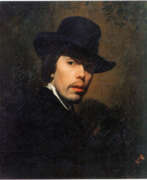

Nikolai Vasilyevich Nevrev (Russian: Никола́й Васи́льевич Не́врев) was a prominent Russian painter, renowned for his genre and historical scenes. Born in 1830 in Moscow into a merchant family, Nevrev's artistic journey began under the tutelage of Mikhail Scotti at the Moscow School of Painting, Sculpture and Architecture from 1851 to 1855. His artistry flourished as he depicted societal critiques and historical narratives with a distinct moral undertone, making significant contributions to Russian visual culture.
Nevrev's paintings, such as "The Bargain" (1866), which illustrates the sale of a serf, and "Oprichniki" (1870s), showcase his mastery in portraying intense dramatic scenes that also reflect social commentaries of the time. His works are celebrated for their deep emotional impact and historical accuracy. Not only did he paint, but he also contributed as a teacher at his alma mater between 1887 and 1890, influencing a new generation of artists.
For those interested in the legacy of Nevrev, his works are displayed in prestigious collections, including the Tretyakov Gallery in Moscow. His life’s work offers an invaluable glimpse into the Russian society of his time and continues to inspire art lovers and collectors worldwide.
For updates on exhibitions and sales related to Nikolai Vasilyevich Nevrev, sign up here. Stay connected to explore the profound narratives captured by this exceptional artist.
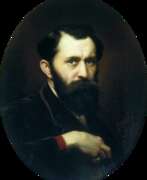

Vasily Grigorevich Perov (Russian: Василий Григорьевич Перов) was a celebrated Russian artist, renowned for his profound contributions to the world of painting. His body of work, characterized by its keen observation and poignant reflection on social issues, established him as a pivotal figure in the realm of 19th-century Russian culture. Perov's specialization in genre painting, alongside his ventures into portraiture and religious themes, showcased not only his versatility but also his deep empathy for the human condition.
Perov's artistry is distinguished by its vivid realism and emotional depth, qualities that marked a departure from the idealized narratives prevalent in the art of his time. His paintings often depicted the stark realities of everyday life, serving as a voice for the marginalized and overlooked sectors of society. This commitment to realism, combined with a masterful command of light and shadow, imbued his works with a powerful sense of immediacy and relevance.
Among his most notable works are "The Last Tavern at the City Gates," "The Arrival of a Governess in a Merchant's House," and "Troika. Apprentices Fetch Water." These paintings, along with others, can be found in prestigious museums and galleries, reflecting Perov's enduring legacy in the pantheon of Russian art. His ability to capture the essence of his subjects with both compassion and critical insight has left an indelible mark on the culture of art and painting.
For collectors and experts in art and antiques, the exploration of Vasily Perov's oeuvre offers a unique window into the socio-cultural landscape of 19th-century Russia. His works not only provide aesthetic pleasure but also invite reflection on the universal themes of human dignity, injustice, and the complexity of social dynamics. To stay informed about new product sales and auction events related to Vasily Grigorevich Perov, sign up for updates. This subscription is a gateway to the rich history and continuing relevance of Perov's artistry, offering exclusive insights into opportunities to own a piece of this illustrious legacy.
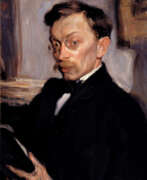

Konstantin Konstantinovich Pervukhin (Russian: Константи́н Константи́нович Перву́хин) was a Russian artist of Ukrainian origin of the late 19th and early 20th centuries. He is known as an impressionist landscape painter, illustrator, and photographer.
Konstantin Pervukhin is considered one of the greatest Russian artists of the turn of the century, continuing the traditions of the Russian landscape school. His work reflected many of the trends characteristic of the art of the time. At the height of his career, the artist used many impressionistic techniques in painting: he painted in a free manner, paying particular attention to the transfer of light and air environment and the changing states of nature.
Pervukhin was a Wanderer and one of the founders of the Union of Russian Artists.


Ivan Pavlovich Pokhitonov (Russian: Иван Павлович Похитонов) was a Russian artist of the late 19th and early 20th centuries. He is known as a painter and graphic artist, a master of landscape, who lived and worked in Europe for much of his career.
Ivan Pokhitonov created mainly miniature landscapes, made with a small brush on planks of red or lemon wood, treated and primed with a special technology. He worked mostly in plein air. The most common motif of his miniature paintings during the years of emigration were city and seascapes of France. In his works, always built on a combination of the finest shades of color, the artist organically combined the techniques of Barbizon, of which he was a fan, and the traditions of the Russian landscape school. He also turned to the genre of still life and portraiture.


Vasily Dmitrievich Polenov (Russian: Васи́лий Дми́триевич Поле́нов) was a distinguished Russian painter, celebrated for his contribution to landscape and historical painting. Born into an enlightened family in St. Petersburg in 1844, Polenov's artistic journey was nurtured by both his heritage and formal education at the Imperial Academy of Arts. His mastery in capturing the serene beauty of the Russian countryside and his innovative approach to biblical themes have cemented his place in the annals of art history.
Polenov's artistry was marked by his pioneering use of plein air painting, a technique that brought a fresh vibrancy and realism to his landscapes. Works such as "Moscow Courtyard" (1878) and "Overgrown Pond" (1879) not only showcase his technical prowess but also reflect his profound connection to Russian rural life and nature. His depiction of biblical scenes, notably in "Christ and the Sinner" (1886–87), broke new ground by intertwining these sacred stories with his love for landscapes, imbuing them with a unique sense of place and time.
A notable period in Polenov's career was his travels in Europe, where encounters with artists and cultures deeply influenced his work. Despite these influences, it was his Russian vistas that garnered the most acclaim, demonstrating his ability to infuse landscapes with a deeply personal and nationalistic sentiment. His commitment to art was intertwined with his belief in its power to evoke happiness and joy, a philosophy that guided his teaching career at the Moscow School of Painting, Sculpture and Architecture, where he mentored future luminaries of Russian art.
Polenov's legacy extends beyond his paintings. His estate, Polenovo, near Tarusa, has been transformed into a national art museum, ensuring that his contributions to Russian art and culture continue to inspire future generations. This dedication to the arts was recognized by his appointment as a People's Artist of the USSR in 1926, a testament to his enduring impact on the cultural landscape.
For art collectors and experts, Polenov's work represents not just aesthetic beauty but a rich narrative of Russia's cultural and natural heritage. His paintings, held in prestigious galleries like the State Tretyakov Gallery and the State Russian Museum, offer a window into the soul of Russian art, marked by a quest for harmony and a deep reverence for the natural world.
For those interested in exploring the works and legacy of Vasily Dmitrievich Polenov further, signing up for updates on new product sales and auction events related to his art can provide valuable insights into his enduring influence. This subscription is an opportunity to stay connected with the world of one of Russia's most beloved artists, ensuring access to the latest offerings and scholarly research surrounding his oeuvre.
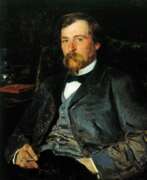

Illarion Mikhailovich Pryanishnikov (Russian: Илларио́н Миха́йлович Пря́нишников) was a distinguished Russian artist, celebrated for his contributions to painting and his role in the Peredvizhniki movement, a group dedicated to portraying real-life subjects through art. Pryanishnikov's work is characterized by its intricate detail, vibrant storytelling, and dedication to depicting the nuances of Russian life and landscapes. His ability to weave narrative, emotion, and cultural critique into his pieces has solidified his status as a pivotal figure in the realm of Russian art.
Pryanishnikov's artistry extends beyond his technical skill, offering a window into the cultural and societal dynamics of 19th-century Russia. His works, such as "Jokers. Gostiny Dvor in Moscow," showcase not only his mastery of form and color but also his keen observation of social interactions and historical context. These pieces are celebrated for their historical accuracy and emotional depth, making them invaluable to both art enthusiasts and historians alike. Pryanishnikov's dedication to realism and social commentary has made his paintings a cornerstone in the study of Russian culture and art history.
For collectors and experts in art and antiques, Pryanishnikov's works represent not just aesthetic beauty but also a profound investment in the rich tapestry of Russian heritage. His paintings, housed in prestigious museums and galleries across Russia, continue to inspire and captivate audiences with their timeless relevance and artistic merit. If you are passionate about the intersection of culture, art, and history, subscribing for updates on new product sales and auction events related to Illarion Mikhailovich Pryanishnikov is an invaluable opportunity. This subscription ensures that you stay informed about the chance to own a piece of Russian art history, directly connecting you to the legacy of one of Russia's most esteemed artists.
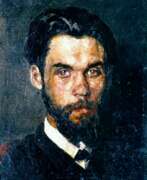

Mykola Kornylovych Pimonenko (Russian: Николай Корнильевич Пимоненко) was a Ukrainian artist who became famous for his significant contribution to world painting. Born in the heart of Ukraine, the artist was deeply imbued with the rich tapestry of Ukrainian culture, which allowed him to convey the essence of rural life with profound realism and emotional depth. His specialization in genre painting and portraiture allowed him to depict the everyday life of his compatriots, which earned him a place of honor among the luminaries of Ukrainian art.
Pimonenko's works are distinguished by their meticulous attention to detail, bright color palette and ability to convey the simple beauty of Ukraine's landscapes and its people. His paintings often depict scenes from peasant life, holidays, and folk traditions, indicating his deep connection to his heritage and his desire to preserve Ukraine's cultural identity through his art.
His masterpieces have found a place in prestigious galleries and museums both in Ukraine and abroad, testifying to his enduring legacy. The National Art Museum of Ukraine and the Tretyakov Gallery in Moscow are among the institutions that house Pimonenko's works, allowing art lovers and collectors to marvel at his contribution to the art world.
For collectors and experts in art and antiques, Timonenko's work represents not only aesthetic beauty, but also a cultural and historical richness that is unparalleled. His ability to weave narrative, emotion and cultural identity into his paintings makes them invaluable to those who appreciate the intricacies of art and history.
If you are an art and antiques collector or expert and would like to keep up to date with new discoveries, sales and auction events related to Nikolai Pimonenko, we invite you to subscribe to updates. This subscription is a customized service designed to keep you up-to-date on the latest happenings in the art world, focusing exclusively on works related to this esteemed artist. Join our community so that you don't miss the opportunity to add a piece of Ukrainian cultural heritage to your collection.


Ilya Yefimovich Repin (Russian: Илья Ефимович Репин) was a preeminent Russian artist, celebrated for his profound influence on the world of art, particularly painting. Born in 1844 in the Russian Empire, Repin distinguished himself as a pivotal figure in bringing Russian art to the forefront of the European scene. His works, characterized by their vivid realism and profound emotional depth, offer a window into the cultural, social, and historical landscapes of 19th-century Russia.
Repin's oeuvre is a testament to his exceptional skill in capturing the essence of his subjects, ranging from the peasantry to the elite, and his commitment to portraying the Russian spirit. His paintings, such as "Barge Haulers on the Volga" and "Ivan the Terrible and His Son Ivan," are lauded for their meticulous detail, dynamic compositions, and the way they convey powerful narratives and emotions. These masterpieces are housed in prestigious museums and galleries worldwide, including the State Russian Museum and the Tretyakov Gallery, affirming Repin's enduring legacy in the annals of art history.
For collectors and experts in art and antiques, Repin's works represent not only significant cultural and historical value but also a deep emotional resonance that transcends time. His ability to intertwine the beauty and tragedy of human experience with the rich tapestry of Russian culture makes his art a compelling exploration for enthusiasts and scholars alike. To stay informed about new product sales and auction events related to Ilya Yefimovich Repin, we invite you to sign up for updates. This subscription is a gateway to exclusive insights and opportunities in the realm of art and antiques, focusing solely on Repin's illustrious work.


Konstantin Apollonovich Savitsky (Russian: Константи́н Аполло́нович Сави́цкий), a distinguished Russian realist painter, carved a unique niche for himself in the annals of art with his profound depictions of the common people's lives, focusing on their struggles and aspirations. Born on May 25, 1844, in Taganrog, Savitsky's early life was marked by personal tragedy and a deep commitment to his craft, which eventually led him to the Imperial Academy of Arts in Saint Petersburg. His talent was evident from his early days, as he garnered several awards, including a gold medal for his painting "Cain and Abel" in 1871, underscoring his exceptional skill and dedication to art.
Savitsky's association with the Peredvizhniki, a cooperative of Russian realist artists who eschewed the academic restrictions of the time, significantly influenced his career trajectory. His works, such as "Repairing the Railroad," highlight the lives of the working class, making a significant impact by bringing the hardships and dignity of ordinary people to the forefront of Russian art. This painting, along with others like "To the War" and "Morning in a Pine Forest" (initially co-credited with Ivan Shishkin), showcase his ability to convey complex social themes through art.
Beyond his contributions to painting, Savitsky's role as the director of the Penza Art School was pivotal in shaping the future of many young artists, emphasizing his commitment not only to art but also to education. His work, characterized by a nuanced understanding of light, composition, and the human condition, remains influential. His paintings are housed in various galleries, including the Tretyakov Gallery and the Penza Regional Picture Gallery named after him, ensuring his legacy endures.
For collectors and art and antiques experts, Savitsky's oeuvre offers a rich tapestry of Russian life and culture, woven with the threads of realism and empathy. His dedication to portraying the essence of peasant life and his innovative approach to art education mark him as a pivotal figure in the development of Russian art.
To stay updated on events, sales, and auctions related to Konstantin Apollonovich Savitsky's work, signing up for updates can provide exclusive access to the latest information and opportunities to acquire pieces by this seminal artist. This subscription ensures that enthusiasts and collectors are always informed about the most relevant and significant developments in the realm of Savitsky's art.


Alexei Kondratievich Savrasov (Russian: Алексе́й Кондра́тьевич Савра́сов), a Russian artist, emerged as a seminal figure in the world of landscape painting, revered for his unique ability to capture the ethereal beauty of Russia's vast countryside. His works, characterized by their emotive force and the infusion of lyrical melancholy, have etched an indelible mark on the fabric of Russian culture and art. Savrasov's genius lies in his pioneering of the "lyrical landscape" genre, which transcends mere representation to evoke deeper emotional resonance with the viewer. His painting "The Rooks Have Returned" (1871) stands as a testament to his mastery, celebrated for its profound simplicity and emotional depth. It showcases his unparalleled skill in depicting the mundane with such nuance and beauty that it transforms into something sublime, thereby earning him a distinguished place among the pantheon of great Russian artists.
Throughout his career, Savrasov was not just a painter but a revered teacher, imparting his knowledge and passion to future generations, including notable figures such as Isaac Levitan. His influence extended beyond his immediate circle, shaping the Russian landscape painting tradition for decades to come. His works, housed in prestigious institutions like the Tretyakov Gallery in Moscow, continue to inspire awe and admiration, serving as enduring symbols of Russia's natural beauty and the emotional depth of its people.
For collectors and experts in art and antiques, Savrasov's paintings offer not just aesthetic pleasure but a deep, resonant connection to the soul of Russian culture. His ability to capture the fleeting moments of nature, rendered with such emotional depth and technical prowess, makes each piece a valuable addition to any collection. As interest in his work remains unwavering, we invite enthusiasts to sign up for updates on new product sales and auction events related to Alexei Kondratievich Savrasov. This subscription is your gateway to the latest acquisitions and opportunities to own a piece of Russian art history, ensuring you stay informed about the most coveted pieces by this illustrious artist.


Valentin Alexandrovich Serov (Russian: Валентин Александрович Серов) was a preeminent Russian artist, renowned for his contributions to painting and his role in bridging the transition between Russian realism and impressionism. Born into the vibrant cultural milieu of 19th-century Russia, Serov's artistic genius was evident from an early age, mentored by the likes of Ilya Repin and later influenced by the works of the French Impressionists. His specialization in portraiture, alongside ventures into historical and landscape painting, showcased not only his versatility but also his profound ability to capture the essence of his subjects.
Serov's body of work is distinguished by its dynamic expression, innovative use of color, and the emotional depth he imbued in his portraits. One of his most celebrated works, "The Girl with Peaches" (1887), stands as a testament to his mastery of light and shadow, heralding the nuances of impressionistic sensibility in Russian art. His portraits of notable figures, such as the composer Alexander Sergeyevich Pushkin and the philanthropist Pavel Tretyakov, have earned him a distinguished place in art galleries and museums worldwide, including the Tretyakov Gallery in Moscow and the Russian Museum in Saint Petersburg.
His influence extends beyond the canvas, contributing significantly to the cultural tapestry of his time. Serov's dedication to capturing the spirit of his era, combined with his technical prowess, has left an indelible mark on the world of art, making his works highly sought after by collectors and art enthusiasts alike. For those keen on the intricacies of cultural evolution through art, Serov's legacy offers a rich field of study and appreciation.
For collectors and experts in art and antiques, Serov's works represent not just aesthetic beauty but also a significant cultural and historical investment. We invite you to sign up for updates on new product sales and auction events related to Valentin Alexandrovich Serov, ensuring you stay informed on opportunities to own a piece of this monumental artist's legacy. This subscription is your gateway to exclusive insights into the world of art collecting, tailored specifically to enthusiasts of Serov's unparalleled contributions to art and culture.
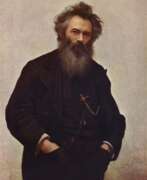

Ivan Ivanovich Shishkin (russian: Ива́н Ива́нович Ши́шкин), a Russian Artist, stood out in the 19th century for his mastery in landscape painting, immortalizing Russia's vast forests and nature through his precise and detailed work. His specialization in painting, coupled with a deep appreciation for his homeland's natural beauty, positioned him as a pivotal figure in Russian culture and art.
Shishkin's technique, characterized by its attention to detail and use of light, brought the Russian wilderness to life on canvas. His works, such as "Morning in a Pine Forest" and "The Rye Field," are celebrated for their realism and ability to evoke the spirit of Russia's landscapes. These paintings, held in prestigious museums like the Tretyakov Gallery in Moscow, serve not only as artistic achievements but also as cultural artifacts that offer insight into the Russian soul.
For art collectors and experts, Shishkin's oeuvre represents an intersection of artistic mastery and cultural heritage. His contributions to the world of painting continue to inspire and captivate audiences, making his works highly sought after in the realms of art collection and preservation.
We invite enthusiasts and connoisseurs to sign up for updates on new product sales and auction events related to Ivan Ivanovich Shishkin. This subscription is your gateway to owning a piece of Russian art history and staying informed about opportunities to acquire works by this illustrious painter.
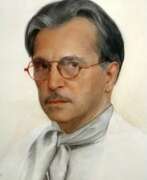

Saveliy Abramovich Sorin (Russian: Савелий Абрамович Сорин) was a Russian painter renowned for his exceptional portrait works. Born in 1878 in Polotsk, Vitebsk province, into a modest Jewish family, Sorin's journey in art took him from Russia to the West, notably France and the USA, where he established himself as a distinguished portraitist by the early 20th century. His education at the Academy of Fine Arts, under the guidance of illustrious teachers including Ilya Repin, laid a strong foundation for his career. Sorin's talent for capturing the essence of his subjects through graceful and precise imagery won him acclaim and a diverse clientele, ranging from aristocrats and royals to fellow artists and cultural figures.
Throughout his career, Sorin lived and worked across various locales, including St. Petersburg, the Crimea, Tiflis, France, and the United States, reflecting a life marked by both artistic and geographic exploration. His notable works include portraits of prominent Russian cultural figures such as Maxim Gorky, Fyodor Chaliapin, Anna Akhmatova, and Tamara Karsavina, showcasing his ability to capture the spirit of Russian culture through his art. Sorin's works are a testament to his skill in combining the richness of color with precise drawing, achieving a remarkable likeness in his portraits.
Saveliy Abramovich Sorin's legacy is preserved in his contributions to art, with many of his pieces donated to museums in the USSR, alongside those held in private collections and museums worldwide. His life and work exemplify the journey of a talented artist navigating the challenges of his time, leaving behind a rich portfolio that continues to captivate and inspire.
For collectors and art experts intrigued by Sorin's legacy and the unique charm of his portraits, staying updated on related sales and auction events is essential. Signing up for updates on Saveliy Abramovich Sorin ensures you remain informed about new opportunities to explore and acquire works by this remarkable artist, enriching your collection with pieces that embody the elegance and depth of early 20th-century Russian portrait art.
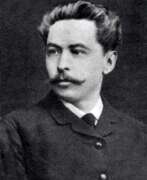

Alexei Stepanovich Stepanov (Russian: Алексей Степанович Степанов) was a distinguished Russian genre painter, illustrator, and art teacher born on May 6, 1858, in Simferopol and passed away on October 5, 1923, in Moscow. Stepanov's early life was marked by tragedy; he lost both parents by the age of five and was subsequently raised in a Moscow orphanage for children of military families. His formal education at the Konstantin Surveying Institute was followed by auditing classes at the Moscow School of Painting, Sculpture and Architecture, where he was influenced by prominent artists of the time.
Stepanov's art career flourished when he began exhibiting with the Peredvizhniki, a group of realist artists, and later helped found the Union of Russian Artists. His works often depict serene rural scenes and everyday peasant life, resonating with a mood of profound emotional depth. Notable works include "Moose Herd," acquired by Pavel Tretyakov, and "Morning Greetings," which earned him the title of Academician from the Imperial Academy of Arts. His work "The Swing" was notably acquired by the Carnegie Museums of Pittsburgh later in his career.
For those interested in the Russian art movement and genre painting, Stepanov's contributions are invaluable. His works can be viewed in major collections such as the State Tretyakov Gallery. To stay updated on exhibitions and sales related to Alexei Stepanov, consider subscribing to updates for collectors and art enthusiasts.


Vasily Ivanovich Surikov (Russian: Василий Иванович Суриков) was a distinguished Russian painter, celebrated for his monumental historical scenes. Born in 1848 in Krasnoyarsk, Siberia, Surikov stands out in the realm of Russian art for his unique ability to breathe life into historical narratives, blending meticulous detail with vibrant emotion. His works are a testament to his profound understanding of Russian history and culture, capturing the essence of significant events with unparalleled depth and dynamism.
Surikov's paintings are renowned for their epic scale and dramatic intensity, qualities that have cemented his reputation as a master of historical genre painting. His notable works include "The Morning of the Streltsy Execution" and "Boyarina Morozova," both of which are housed in the Tretyakov Gallery, Moscow. These paintings exemplify Surikov's skill in portraying the human condition amidst the tumult of historical change, making him a pivotal figure in Russian art history.
For collectors and experts in art and antiques, Surikov's oeuvre offers a fascinating insight into Russian culture and the artistic excellence of the 19th century. His ability to merge historical accuracy with artistic expression makes his works highly sought after in the realms of collection and study. As we continue to explore and appreciate the depth of Russian art, Surikov's legacy serves as a compelling chapter in the story of cultural heritage and artistic achievement.
To stay informed about new product sales and auction events related to Vasily Ivanovich Surikov, sign up for updates. This subscription is your gateway to the world of historical art, offering exclusive insights and opportunities to enrich your collection with pieces of significant cultural value.
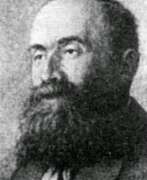

Sergey Ivanovich Svetoslavsky (Russian: Сергей Иванович Светославский) was a Russian Ukrainian and Soviet artist of the late 19th - first third of the 20th centuries. He is known as a painter-landscaper and graphic-caricaturist.
Sergey Svetoslavsky in his works created a lyric-epic image of Ukraine. Most of all he was attracted by the urban landscapes of Kiev and rural landscapes around the city. One of his favorite subjects were views of the Dnieper. The master was a member of the Association of Traveling Art Exhibitions and his city landscapes were done mainly in gray-brown tones, which was typical for the Itinerants.
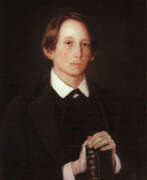

Apollinariy Mikhailovich Vasnetsov (Russian: Аполлина́рий Миха́йлович Васнецо́в) was a distinguished Russian painter and architect, celebrated for his pivotal role in bridging the realms of historical and landscape painting with a unique artistic vision. Born into a family with a deep artistic lineage, Vasnetsov's work was heavily influenced by Russian culture, history, and the natural landscape, which he depicted with a meticulous attention to detail and a vivid imagination. His specialization in creating historically accurate and vividly imagined views of ancient Russia set him apart from his contemporaries and solidified his status as a key figure in the Russian art world.
Vasnetsov's oeuvre is notable for its dedication to showcasing the beauty and complexity of Russia's past. His paintings often feature medieval and ancient Russian cities, imbuing them with a sense of romanticism and nostalgia. Among his most renowned works are his breathtaking views of the old Moscow, which are celebrated for their historical accuracy and atmospheric depth. These pieces not only offer a window into the past but also reflect Vasnetsov's profound love and understanding of Russian history. His works are housed in prestigious museums and galleries across Russia, serving as a testament to his lasting impact on the art world.
For collectors and experts in art and antiques, Vasnetsov's work represents a unique investment in Russian culture and heritage. His ability to weave together historical accuracy with artistic beauty makes his paintings highly sought after. We invite enthusiasts and collectors to stay informed on new discoveries, product sales, and auction events related to Apollinariy Mikhailovich Vasnetsov's work by signing up for updates. This subscription is your gateway to the latest offerings and opportunities to add a piece of Russian history and culture to your collection.
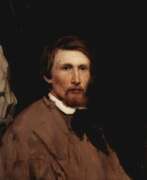

Victor Mikhailovich Vasnetsov (Russian: Виктор Михайлович Васнецов) was a seminal Russian artist, whose contributions to the world of art have left an indelible mark on cultural history. Born into a priest's family in 1848, Vasnetsov's journey into the realms of painting and sculpture was not just a pursuit of aesthetic beauty, but a mission to delve deep into the soul of Russian folklore and history. His works, characterized by their vivid storytelling and intricate detail, bridge the gap between the ethereal world of legends and the tangible reality of Russian cultural identity.
Vasnetsov's oeuvre is a testament to his versatility as an artist, spanning across genres from historical to mythological subjects. Among his most celebrated works are "The Bogatyrs" and "The Knight at the Crossroads," which not only showcase his mastery in painting but also reflect his deep engagement with the themes of heroism and destiny, central to Russian folklore. These masterpieces, housed in prestigious museums like the Tretyakov Gallery in Moscow, continue to captivate audiences with their compelling narratives and exquisite execution.
What sets Vasnetsov apart is not just his artistic skill, but his ability to encapsulate the essence of Russian culture and mythology in his work, making it an invaluable part of Russia's cultural heritage. His paintings are more than just visual spectacles; they are windows into the soul of a nation, narrating stories that have shaped the collective consciousness of the Russian people. For collectors and experts in art and antiques, Vasnetsov's works represent a confluence of historical significance and unparalleled artistic merit.
To stay abreast of the latest updates on sales and auction events featuring the works of Victor Mikhailovich Vasnetsov, we invite you to sign up for our updates. This subscription is tailored specifically for enthusiasts of culture, art, and antiques, ensuring you receive timely information on opportunities to add to your collection of valuable pieces.


Vasily Alekseyevich Volkov (Russian: Василий Алексеевич Волков) was a Russian and Ukrainian artist of the last third of the 19th - early 20th centuries. He is known as a painter, watercolorist and teacher.
Vasily Volkov painted portraits and paintings on domestic and historical themes. Especially famous are his portraits of Emperors Alexander II and Alexander III, as well as historical portraits.


Nikolai Alexandrovich Yaroshenko (Russian: Николай Александрович Ярошенко) was a prominent Russian painter of Ukrainian origin, recognized for his profound contributions to genre and portrait painting, particularly focusing on societal themes and the daily struggles of working people. Born on December 13, 1846, in Poltava, then part of the Russian Empire, Yaroshenko initially pursued a military career before devoting himself to art.
Yaroshenko became an influential member of the Peredvizhniki, a group of Russian realist artists who sought to portray real life with a moral or social message. His works are notable for their depth of emotion and social commentary, highlighting the lives of the common folk and the societal challenges of the time. Among his well-known paintings are "The Stoker" and "The Prisoner," both of which reflect his concern for the plight of the oppressed and showcase his skill in evoking empathy through art.
Many of Yaroshenko's masterpieces are housed in prominent Russian museums, such as the Tretyakov Gallery, reinforcing his status in the annals of art history. His works continue to resonate, providing insight into the social dynamics of 19th-century Russia and the struggles therein.
For art collectors and experts interested in the poignant realism and historical depth of Yaroshenko's paintings, staying updated on exhibitions and auctions featuring his work can be incredibly rewarding. To receive alerts about new sales and auction events related to Nikolai Alexandrovich Yaroshenko, consider signing up for updates through specialized art platforms.


Stanislav Yulianovich Zhukovsky (Russian: Станислав Юлианович Жуковский) was a Polish-Russian painter, renowned for his contribution to the Impressionist movement and a member of Mir iskusstva. Born in 1873 in Yendrikhovtsy, Grodno Province, he showcased a remarkable journey from a student of Isaac Levitan at the Moscow School of Painting to becoming one of the most celebrated landscapists of his time. His works, deeply influenced by impressionistic methods and the Russian realist school, offered a vivid portrayal of Russian landscapes, pre-revolutionary sites, and the interiors of Russian estate houses.
Zhukovsky's art reflected a unique blend of realism and impressionism, capturing the subtle shifts in nature and the delicate nuances of light and color. His landscapes, often depicting the changing seasons and times of day, resonated with lyrical beauty and a sense of nostalgia for the old manor culture, making him a significant figure in the Silver Age of Russian culture. Despite his skepticism towards the Bolshevik revolution, which eventually led him to relocate to his ancestral homeland, Poland, in 1923, his legacy continued to flourish. His later years were marked by hardship, including his arrest and death in a prisoner transit camp during the German occupation of Poland in World War II.
Zhukovsky's artworks, such as "A Country House at Dusk in Winter" and "Interior With Samovar," are celebrated for their atmospheric depth and the masterful use of color and light, embodying the spirit of Russian impressionism. His influence extended beyond his canvases, as he mentored future luminaries like Liubov Popova and Vladimir Mayakovsky.
For collectors and experts in art and antiques, Zhukovsky's oeuvre represents a poignant exploration of the Russian landscape and cultural identity, rendered with a sensitive, impressionistic touch. His works, preserved in museums and private collections, continue to inspire and captivate audiences with their timeless beauty and emotional depth.
To stay informed about new discoveries, exhibitions, and auction events related to Stanislav Yulianovich Zhukovsky, sign up for updates. This subscription ensures that you won't miss the opportunity to engage with the legacy of this remarkable artist, whose work captures the essence of a pivotal era in Russian art history.
